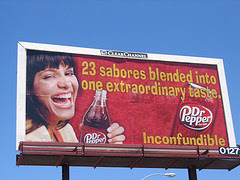Podcast 74. Spanglish (Escuchar / Listen)
El Spanglish es un nuevo idioma, se trata de una mezcla entre español e inglés y también se le llama “Espanglish” o “Spanish Broken”. Consiste en mezclar en la misma frase ambas lenguas empleando términos ingleses sin traducir. Más de 35 millones de hispanos residentes en Estados Unidos lo hablan.
A la mayoría nos resulta gracioso oír a alguien decir cosas como “voy a parkear el coche” o “dame las keys”, mientras que otros, como el director del Instituto Cervantes, piensan que la mezcla acaba con lo bueno de los dos idiomas.
Sin embargo, tanto si nos gusta como si no el Spanglish es una realidad para los millones de latinos que viven en Nueva York y no se habla sólo en la calle, también ha llegado a los periódicos donde se publican diariamente tiras cómicas como la “Cucaracha”, carteles publicitarios, anuncios en prensa, programas infantiles en televisión como “Dora la Exploradora” o “Plaza Sésamo”, incluso se ha llegado a traducir a este nuevo idioma el primer capítulo de Don Quijote de la Mancha.
Quizá necesite regularse de alguna forma pero lo que es cierto es que siendo la tercera lengua más hablada en Nueva York estamos ante un fenómeno de comunicación que no puede ser ignorado.
Spanglish
Spanglish is a new "language" made up from Spanish and English. It’s also called “Espanglish” or “Broken Spanish”. It is a blend of both languages used in the same sentence introducing English terms instead of translating them.
More than 35 million Hispanic residents of the United States speak it.
Some Spanish speakers find funny to hear somebody saying things like “voy a parkear el coche” or “dame las keys”;on the other hand, people like the Director of the New York Cervantes Institute thinks that the mix of both spoils the magnificent of each language.
Nevertheless it doesn’t matter if we like it or not , Spanglish is a reality for millions of Latin Americans living in New York and this language is not only spoken in the streets; it’s also in newspapers where strip cartoons like “La Cucaracha” are published every day. There are also posters, adverts, children’s television programs as “Dora la exploradora” or “Plaza Sesamo”.Likewise they have even translated to this new language a chapter of the Spanish book “Don Quijote de la Mancha”.
This language needs to be regulated but being the third language spoken in New York we are faced with a communication phenomenon that we can’t ignore.
A la mayoría nos resulta gracioso oír a alguien decir cosas como “voy a parkear el coche” o “dame las keys”, mientras que otros, como el director del Instituto Cervantes, piensan que la mezcla acaba con lo bueno de los dos idiomas.
Sin embargo, tanto si nos gusta como si no el Spanglish es una realidad para los millones de latinos que viven en Nueva York y no se habla sólo en la calle, también ha llegado a los periódicos donde se publican diariamente tiras cómicas como la “Cucaracha”, carteles publicitarios, anuncios en prensa, programas infantiles en televisión como “Dora la Exploradora” o “Plaza Sésamo”, incluso se ha llegado a traducir a este nuevo idioma el primer capítulo de Don Quijote de la Mancha.
Quizá necesite regularse de alguna forma pero lo que es cierto es que siendo la tercera lengua más hablada en Nueva York estamos ante un fenómeno de comunicación que no puede ser ignorado.
Spanglish
Spanglish is a new "language" made up from Spanish and English. It’s also called “Espanglish” or “Broken Spanish”. It is a blend of both languages used in the same sentence introducing English terms instead of translating them.
More than 35 million Hispanic residents of the United States speak it.
Some Spanish speakers find funny to hear somebody saying things like “voy a parkear el coche” or “dame las keys”;on the other hand, people like the Director of the New York Cervantes Institute thinks that the mix of both spoils the magnificent of each language.
Nevertheless it doesn’t matter if we like it or not , Spanglish is a reality for millions of Latin Americans living in New York and this language is not only spoken in the streets; it’s also in newspapers where strip cartoons like “La Cucaracha” are published every day. There are also posters, adverts, children’s television programs as “Dora la exploradora” or “Plaza Sesamo”.Likewise they have even translated to this new language a chapter of the Spanish book “Don Quijote de la Mancha”.
This language needs to be regulated but being the third language spoken in New York we are faced with a communication phenomenon that we can’t ignore.




No hay comentarios:
Publicar un comentario